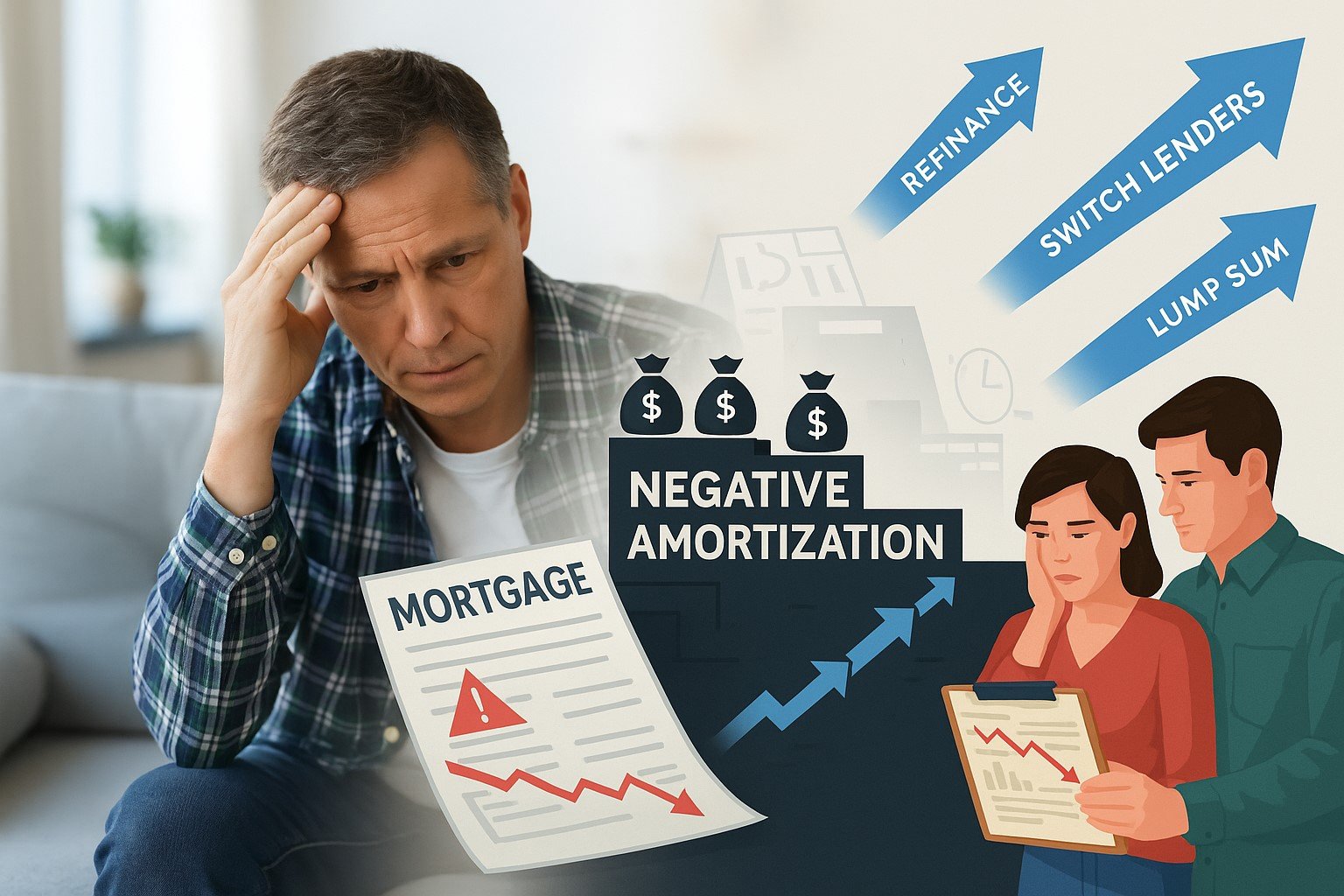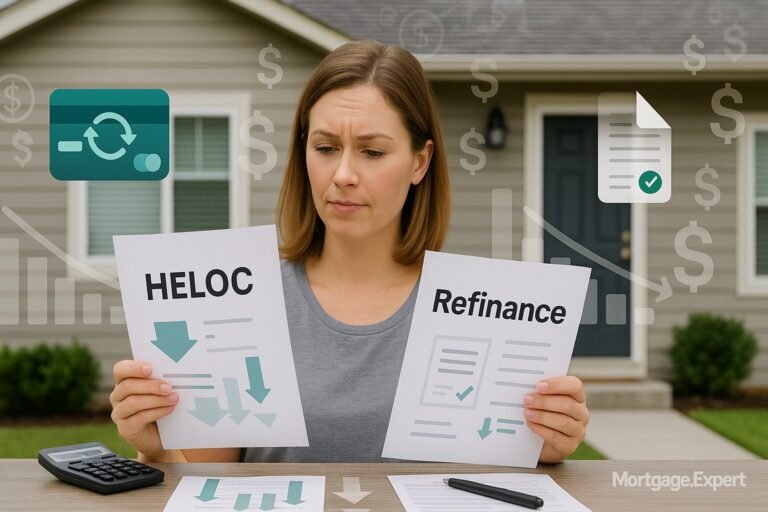
5 Ways to Get Out of Negative Amortization on Your Mortgage
Struggling with negative amortization? Discover 5 smart ways Canadian homeowners can stop their mortgage balance from growing in 2025.
Table of contents
- What is Negative Amortization?
- How Negative Amortization Happens
- How to Get Out of Negative Amortization
- Frequently Asked Questions
- Final Thoughts
If you have a mortgage, you’re likely familiar with the concept of amortization. It’s the process of gradually paying off your loan over time through regular payments. This helps you grow your home’s equity. However, a scenario called negative amortization can hinder your progress and even put you in financial trouble. Negative amortization happens when your monthly mortgage payments are not enough to cover the interest owed, causing your loan balance to grow instead of shrink.
This guide will break down how negative amortization works, why it’s important to address it quickly, and five proven strategies to escape it before it snowballs.
Key Highlights
- Negative amortization increases your loan balance over time.
- It often stems from variable-rate or interest-only mortgages.
- You can tackle it by increasing payments, locking in a fixed rate, refinancing, adjusting terms, or consulting a mortgage expert.
What is Negative Amortization? Negative amortization occurs when your mortgage payment isn’t high enough to cover the interest portion, let alone reduce the principal. That unpaid interest is then added to your total loan, making your mortgage grow month after month.
📌 What Is Negative Amortization?
📉 Normal Amortization
- ✅ Payment > Interest
- ✅ Principal shrinks
- ✅ Loan balance decreases
- ✅ Equity builds over time
🚫 Negative Amortization
- ⚠️ Payment < Interest
- ⚠️ Unpaid interest added to balance
- ⚠️ Loan balance grows
- ⚠️ Risk of payment shock
🔍 Quick Comparison
| Feature | Normal Amortization | Negative Amortization |
|---|---|---|
| Monthly Payment | Covers interest + principal | Covers only part of interest |
| Loan Balance | Decreases over time | Increases over time |
| Equity Built | Yes | None or very little |
| Payment Shock Risk | Low | High |
| Common With | Fixed-rate mortgages | VRMs, Interest-only loans |
This is common with:
- Variable-rate mortgages (VRMs), where fixed payments stay the same even when rates go up
- Interest-only payment plans, which let you delay paying off the principal entirely
In both cases, if the interest rates rise or you don’t start paying down principal soon enough, your mortgage balance can spiral upward instead of down.
How Negative Amortization Happens
- VRMs with Static Payments: When rates rise, the interest portion grows. If your payments are fixed and can’t cover it, the excess gets tacked onto your loan. That’s hitting the “trigger rate.”
- Interest-Only Periods: These plans delay principal payments for a while. But when the interest-only term ends, you face significantly higher payments, often leading to negative amortization if you’re not ready.
How to Get Out of Negative Amortization
Method 1: Increase Your Payments The simplest fix? Pay more. Bump up your regular payments or make lump-sum contributions to knock down the growing principal. Even small top-ups can slow or stop the balance from increasing. Just check your prepayment privileges to avoid penalties.
Method 2: Switch to a Fixed-Rate Mortgage If rate hikes are causing the issue, locking in a fixed rate provides predictability. It won’t solve the growing balance instantly, but it protects you from further volatility.
Bonus: Consider switching to an adjustable-rate mortgage (ARM), which recalculates payments based on rates—reducing the risk of deferred interest piling up.
Method 3: Refinance Your Mortgage Refinancing means replacing your existing loan with a new one—often with better terms. If your credit score is strong and home equity is solid, this can reset your amortization and monthly payments to something more manageable.
📋 Sample Payments Before and After Fixing Over-Amortization
This table compares the monthly mortgage payments and loan balance for a borrower experiencing negative amortization versus after implementing corrective action such as increasing payments or refinancing.
| Scenario | Monthly Payment | Interest Paid | Loan Balance After 2 Years |
|---|---|---|---|
| Before Fix (Negative Amortization) | $1,800 | $45,000 | $518,000 |
| After Fix (Increased Payment) | $2,200 | $39,000 | $495,000 |
Note: These figures are for illustrative purposes only. Actual results vary based on rate changes, lender terms, and timing of prepayments.
Tips:
- Shop for lower rates
- Use a mortgage calculator to assess savings
- Refinance into a shorter term if possible
Method 4: Adjust Your Amortization Term If higher payments aren’t feasible, ask your lender to stretch your amortization schedule. This can lower monthly costs and stop the bleeding, though it may increase long-term interest. It’s a strategic pause, not a cure—but sometimes it’s what you need.
Method 5: Get Professional Help Mortgage brokers, advisors, or even real estate lawyers can help you navigate complex cases. They might suggest loan modifications, negotiate terms, or even help you weigh whether selling and downsizing is your best option.
Frequently Asked Questions
Q: What should I do if my mortgage has a negative amortization? A: Increase payments, make a lump sum contribution, or switch to a mortgage type that better suits your cash flow.
Q: What happens if my home is worth less than my mortgage? A: You may need to pay the difference out-of-pocket when renewing or selling. Consider refinancing, extending your amortization, or selling if needed.
Q: Is negative amortization illegal in Canada? A: No, but lenders must clearly disclose the risks and limits—usually capped at 105% LTV for insured mortgages and 80% LTV for uninsured ones.
Q: Is this the same as a reverse mortgage? A: No. A reverse mortgage adds interest to the loan intentionally, usually for seniors accessing equity. Negative amortization is unintended and risky.
Final Thoughts If you’re caught in negative amortization, don’t wait it out—it rarely gets better on its own. Tackle it early by boosting payments, exploring mortgage options, or speaking to a trusted advisor.
💬 Get Advice From a Canadian Mortgage Expert
Confused about over-amortization or rising payments? Our trusted advisors can help you understand your mortgage options, and guide you toward the best solution for your financial situation.
📞 Talk to an Expert NowStuck with a Mortgage Decision?
Don’t stress — our team is here to help. Reach out for free, no-obligation guidance.
Contact the Experts



